In a recent interview with The Mirror, Toulouse forward Rhys Healey (180cm/5’10”, 72kg/158lbs) explained “it was a dream come true” for him when he replaced former Manchester City, West Ham United and Liverpool attacker Craig Bellamy to make his EPL debut for Cardiff City in the final day of the Welsh club’s unsuccessful 2013/14 campaign. The right-footed Manchester-born attacker would have to wait until the 2018/19 season to appear once more in the English Premier League, with Healey making a total of just three appearances for Neil Warnock’s side that term.
While Healey was seemingly deemed below par for Warnock’s first-team plans in 2018/19, the then-Cardiff boss did speak fondly about the Englishman who moved to the Cardiff City Stadium from Connah’s Quay in Wales’ second-tier back in January 2013, dubbing the forward: “a little rash because he never leaves defenders alone” and declaring that Healey’s “honesty will make him a good living” in football.
Warnock’s ‘little rash’ left Cardiff permanently to join MK Dons in 2019, having spent part of the 2018/19 campaign on loan at Stadium MK, and since then, his career has gone from strength to strength. He scored 11 goals in 19 games for MK Dons in 2019/20, playing a key role in helping his side to secure a 19th-place finish and avoid relegation that term. In the summer of 2020, Healey then secured a move to Toulouse, who had been relegated from Ligue 1 at the end of 2019/20, with the ex-Connah’s Quay man being recruited to boost Toulouse’s bid for an immediate return to the top-flight.
Though a strong Toulouse side failed to earn promotion to Ligue 1 last season, Healey made a good impression on Les Violets’ supporters by scoring 14 goals — ending the season as Ligue 2’s joint-fourth highest goalscorer — earning the affectionate moniker: “our Jamie Vardy” from Toulouse, and French football, fans. Regardless of whether or not Healey prefers this nickname to the one Warnock bestowed onto him, Les Violets’ Jamie Vardy hasn’t let the adulation go to his head, as he’s started the 2021/22 season in fine form, scoring seven goals in his first 14 appearances this term, making him Ligue 2’s joint-second highest scorer, at present.
This tactical analysis and scout report aims to highlight the Connah’s Quay academy product’s greatest strengths, looking at his role within Philippe Montanier’s strategy and tactics at Stadium TFC and how it’s suited to the 26-year-old’s best qualities. I aim to highlight both what Healey is, through analysis of what he brings to the table, and what he isn’t, by looking at some deficiencies and potential areas of improvement within his game.
The striker could be regarded as a late bloomer bursting onto the scene in France’s second-tier or as an asset who’s just now accentuating his best assets while masking his weaknesses to great effect thanks to his role under Montanier. Either way, with just over 18 months on the 26-year-old’s Toulouse contract, I feel that Healey is one that clubs of a higher stature — particularly in his native Britain — should be keeping tabs on, as if the striker decides he wants to leave France at the end of his current run with Toulouse, he could represent a shrewd bit of business for, say, a second-tier English club.
Offensive positioning and movement
I’ll kick off this scout report by looking at Healey’s offensive positioning and movement — which are key aspects of his game that are very important to be aware of in order to develop an understanding of his overall game as a striker.
In the last calendar year, Healey’s scored more goals (21) than any other player in France’s second-tier. Additionally, he’s generated the best xG (19.46 — which he’s overperforming) of any Ligue 2 player. While, as mentioned previously, Healey is currently the second-highest scorer in Ligue 2 with seven goals, he’s also got the highest xG in the league this term (6.86).
These numbers don’t just tell us about his prolific nature in front of goal — they also tell us about the quality of chances he’s enjoying and his efficiency at converting chances over the past year. Healey also outperformed his xG by a considerable amount during the 2019/20 season at MK Dons and this consistent overperformance effectively paints the picture of a pretty efficient finisher. His relatively high (for a Ligue 2 striker) 15.909% conversion rate further backs this up.
When Healey plays, Toulouse’s main aim in attack is essentially to get the ball to the Englishman in high-value positions where he can use his impressive finishing ability to great effect. Les Violets are very good at doing this, hence why Healey has taken the third-most shots (3.27 per 90) of any Ligue 2 striker this term and why he’s scoring so many goals right now.
Healey’s positioning and movement plays an important role in this strategy. It’s not just on his teammates to build the attack and lay chances on a plate for him — he also needs to create space for himself and position himself well, in those previously mentioned high-value areas, to receive the ball and be able to finish quickly. His role in the side requires a good understanding with his teammates and intelligence in terms of what he does on the ball (which is usually in the box) and off the ball.
Healey doesn’t tend to get heavily involved in the attack, on the ball, outside of finishing chances. Even when his team has progressed into the final third, Healey doesn’t get heavily involved in the play. His primary role during this phase is to create space for himself and get in a good, high-value goalscoring position — not link up with teammates.
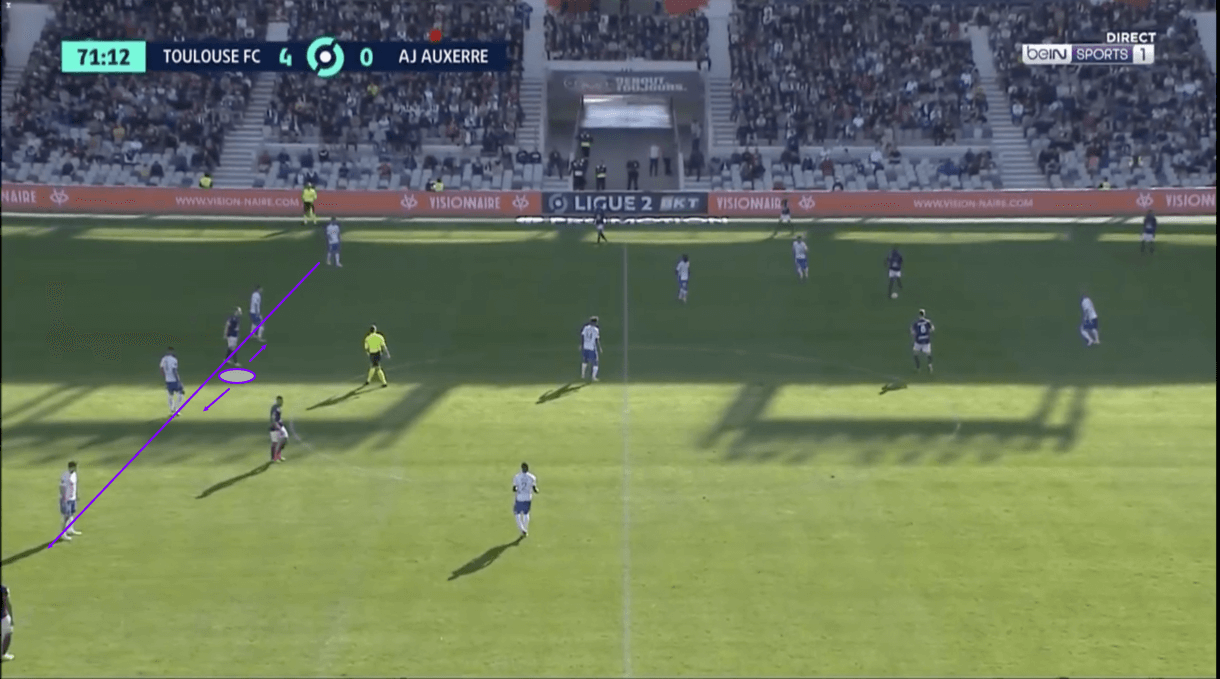
Figure 1 shows an example of Toulouse in the ball progression phase of play, with Les Violets looking to build into the opposition’s half, while the opposition are sitting in a mid-block, with a well-organised backline sitting just beyond the centre-circle. Joining Auxerre’s back-four here, in the very middle, is Rhys Healey, who we see taking up a very typical position for him during this stage of an attack.
Whereas you’ll find some forwards dropping off to exploit space in between the lines and receive the ball to feet in this phase and you’ll find some forwards backing into a defender to use their body to hold up the ball in this phase, Healey looks to get between defenders. He aims to enjoy some freedom, with no one particular defender picking him up, by getting between the defenders with a fairly similar distance between him and each defender. This can create some uncertainty over who’s man he should be.
Additionally, this positioning creates space behind Healey to quickly turn and burst into, rather than having a defender behind him who he can’t just run through. This is important as Healey doesn’t typically want to receive the ball to feet, he wants to run onto a pacey ball played into the space in front of him that he can chase in behind the opposition’s backline.
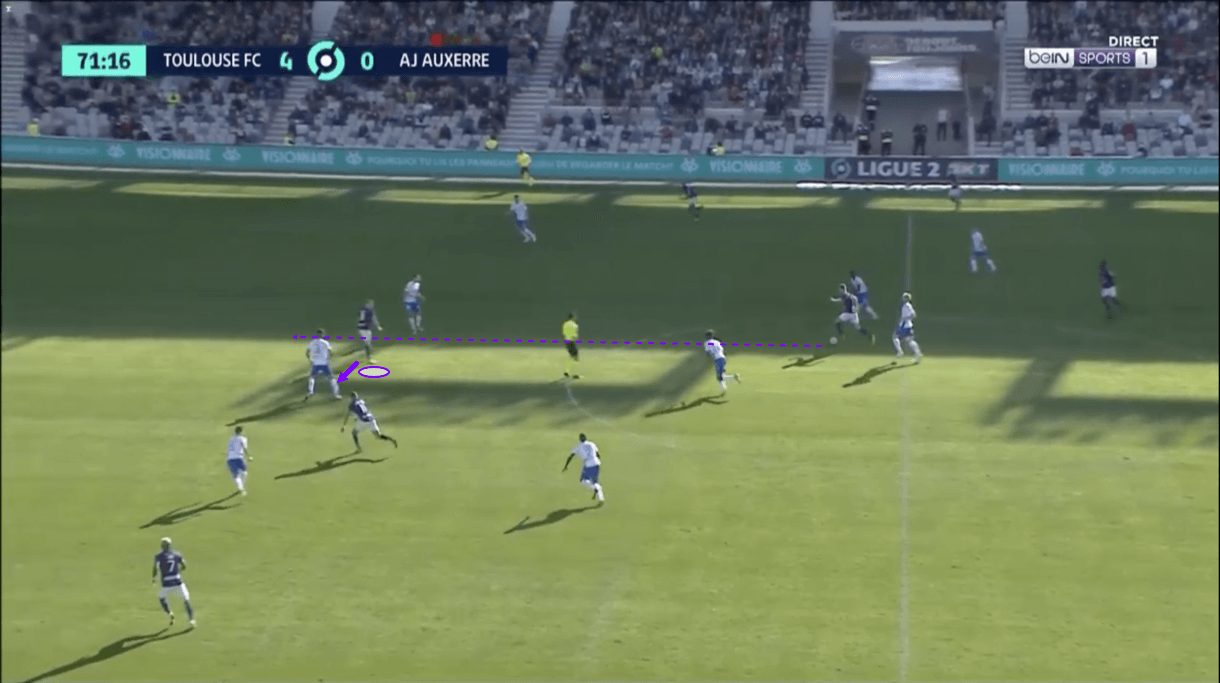
To create this optimal scenario for Healey when the striker is starting with his back to goal, the pass to him must be driven with pace so he can adjust his body positioning while the ball comes towards him to allow the pass to run beyond him and into the space where he can then chase it down. However, more commonly, we see Healey adjust his body positioning before the pass is played, as was the case when this particular passage of play moved on into figure 2.
As Toulouse progressed into Auxerre’s half here, we see Healey adjust his positioning based on the position of the teammate in possession. As the teammate is driving through the centre but slightly on the right side of central midfield, Healey begins to pull away ever so slightly to the left, creating some more space in the lane right in front of the ball-carrier for this player to drive a pass through for Healey, who could then chase that ball in behind. It’s also important to note that as Healey pulls over to the left here, he begins turning to face the opposition’s goal — again, to make it easier for him to chase this through pass in behind as soon as it’s played.
On this occasion, Healey drags the opposition’s left centre-back with him as he pulls away, which closes the space in the passing lane he was hoping to open, but opens another passing lane between the opposition’s left centre-back and left-back. As play moves on, we see the ball-carrier drive the ball through this gap for the right-winger to chase, while Healey can burst in behind to make himself a low crossing option for the winger too. Thanks to his very impressive pace, Healey is capable of driving forward and losing defenders very quickly in situations like this, to make himself an attractive low crossing option with no defenders around him. Healey’s blistering pace also helps him to chase down through passes in behind the defensive line effectively, highlighting a key reason for why he plays like this.
You’ll often find Healey at the very top of his side’s attack, sitting on the shoulder of the opposition’s backline, as we saw in this example. His qualities aren’t in what he could offer his side by linking up in chance creation, rather they’re in the threat he poses to the open space behind the opposition’s backline. This can drive defenders backwards to create more space between the lines, drag defenders out of position (as we saw here) or create through passing opportunities for Toulouse that Healey could capitalise on via his pace. The 26-year-old does an excellent job of providing depth for his side at the top of the pitch.
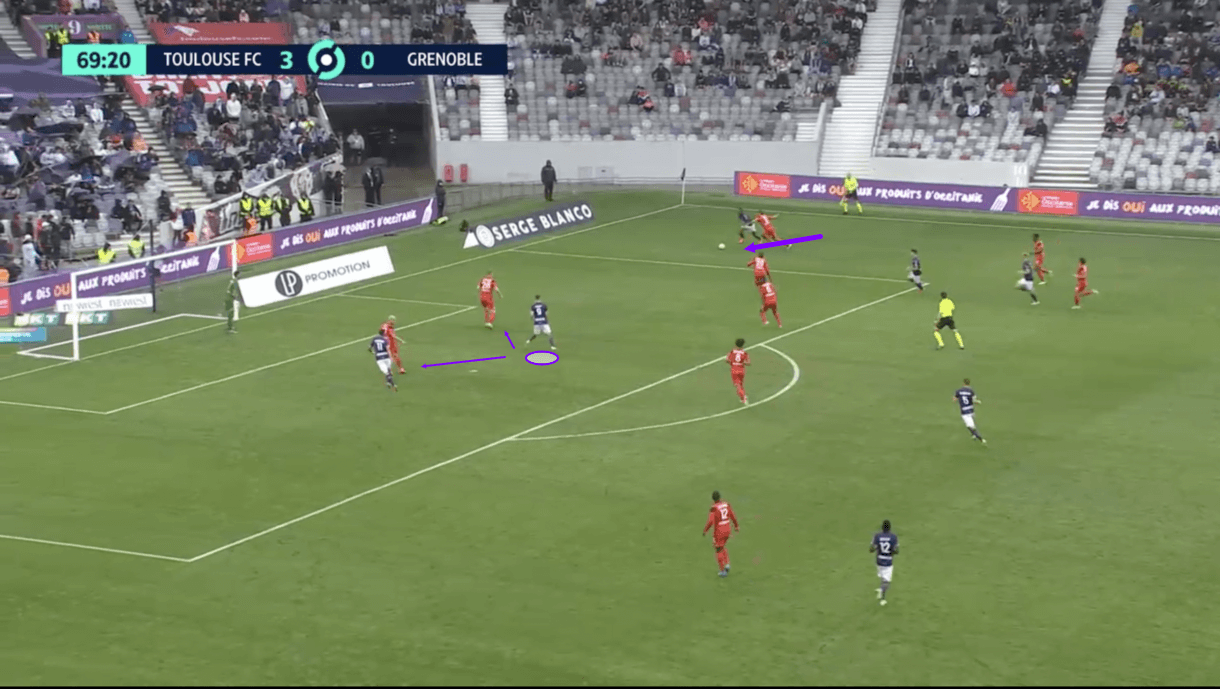
Figure 3 shows an example of Healey positioned inside the opposition’s box, while Toulouse’s right-winger has the ball and is in the process of bursting past the opposition’s left-back on the right flank. In the box, Healey operates with a similar set of principles to what he demonstrated in the previous example. While he’s deeper than the opposition’s backline on this occasion — because he doesn’t need to sit on their shoulders when the ball is so far advanced and there’s no space behind them to exploit — he remains very central and at a somewhat similar distance from both centre-backs.
At this point of an attack, it’s typical to find Healey positioned close to the penalty spot (a very high-value position) exploiting a spot of free space, if it’s available. This provides an example of his intelligent positioning, with a view to being ready to take a shot from a high-value position should his teammates work the ball to him. He does well here to maintain a decent distance from the two centre-backs — something he usually tries to do — while observing his right-winger progress into a dangerous position to pull the ball back into the box.
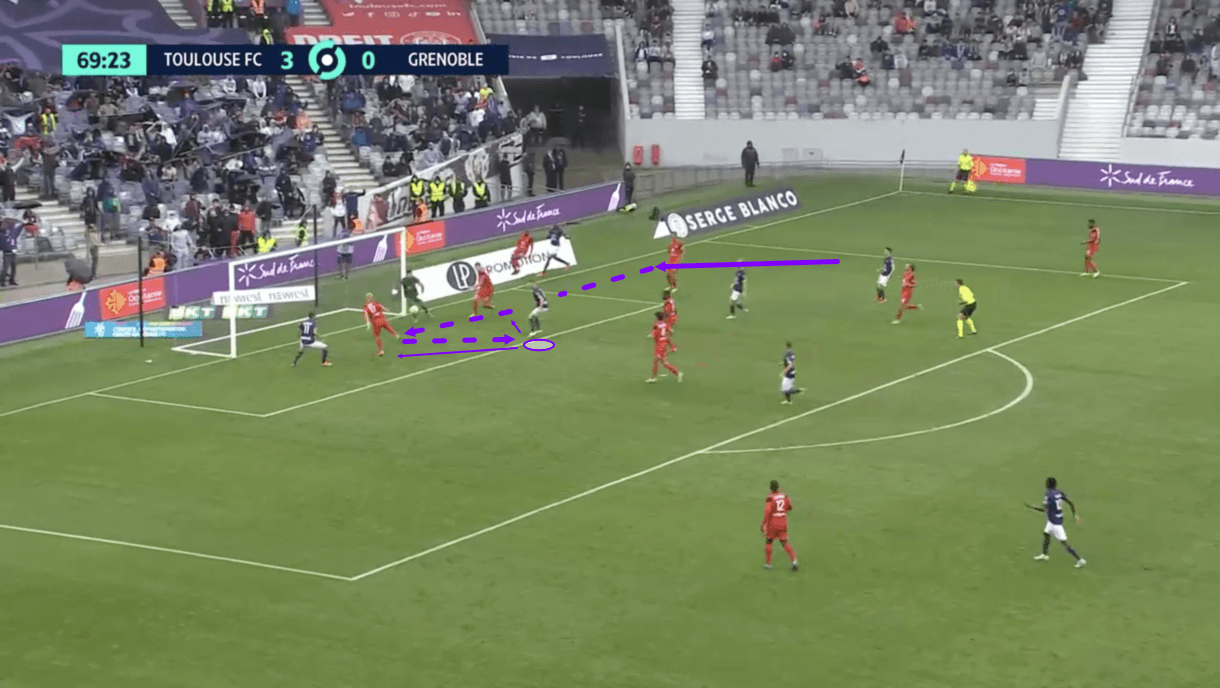
As this passage of play moves on into figure 4, we see that the right-winger’s cross was actually directed towards Healey’s teammate running towards the back post but as that attempted cross was blocked, it fell into the Englishman’s feet, and Healey enjoyed a goalscoring opportunity from a very, very dangerous position here — created partially by his intelligent positioning and movement during the chance creation phase.
Healey’s subsequent shot was actually saved by the goalkeeper but regardless of the outcome, this provides an example of how the 26-year-old is generating such an impressive xG and, ultimately, why he’s scoring so many goals. His off-the-ball movement and intelligent positioning are key to Toulouse’s attack, and Les Violets’ goal of finding the efficient finisher in space to shoot in high-value positions.
Not one for link-up play
Again, as mentioned, Healey isn’t a centre-forward who likes to drop deep, link up with teammates and play with his back to goal. The Toulouse man isn’t heavily involved in his team’s play at all, on the ball, up until he’s required to finish chances. His main role in possession phases, besides finishing, centres around his off-the-ball movement and ability to create space for himself, as opposed to any on-the-ball contribution.
Healey has played a very low number of passes (10.74 per 90) this season, which reflects his low involvement on the ball in possession phases and lack of significant involvement in link-up play. Similarly, as you might expect, Healey doesn’t play many threatening, creative passes; he’s an efficient finisher, not a playmaker.
This provides some important information concerning what kind of player Healey is. His strengths lie in his off-the-ball movement and positioning, not in his technical passing ability. As well as technical ability, the Englishman’s decision-making sometimes lets him down when it comes to passing, as we’ll see in this section of analysis.
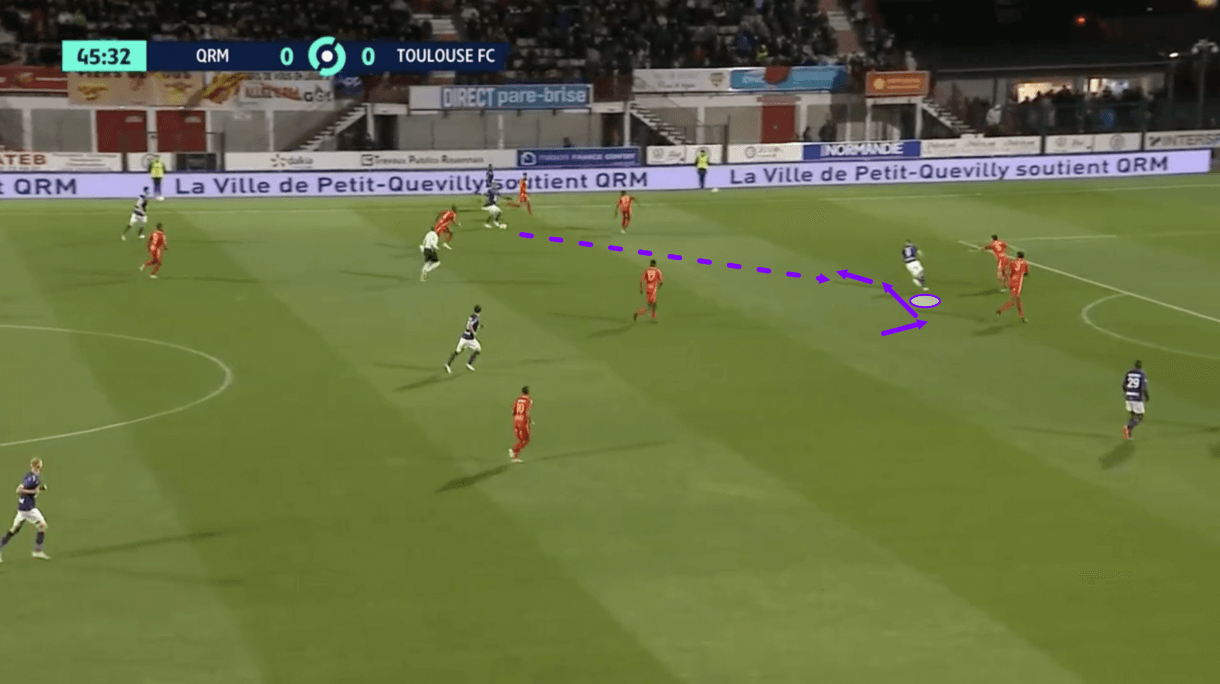
Figures 5-6 highlight one passage of play in which Healey’s technical ability and decision-making were on display, as the forward dropped off from his centre-forward position to link up with deeper teammates while building an attack. Starting with figure 5, here, we see an example of Healey shifting from his typical, central position, into a slightly wider position to the left of his team’s forward line.
The 26-year-old’s aim here was to provide an option for his teammate carrying the ball up the left flank, who’s become surrounded by opposition bodies in figure 5. The forward succeeded in doing this, as we see him successfully receive the forward pass from the ball-carrier as play moves on from figure 5.
This shows some good movement and positional awareness from Healey. His decision to change the direction of his run and position himself differently to where we normally see him was beneficial for his team on this occasion as it promoted ball progression upfield.
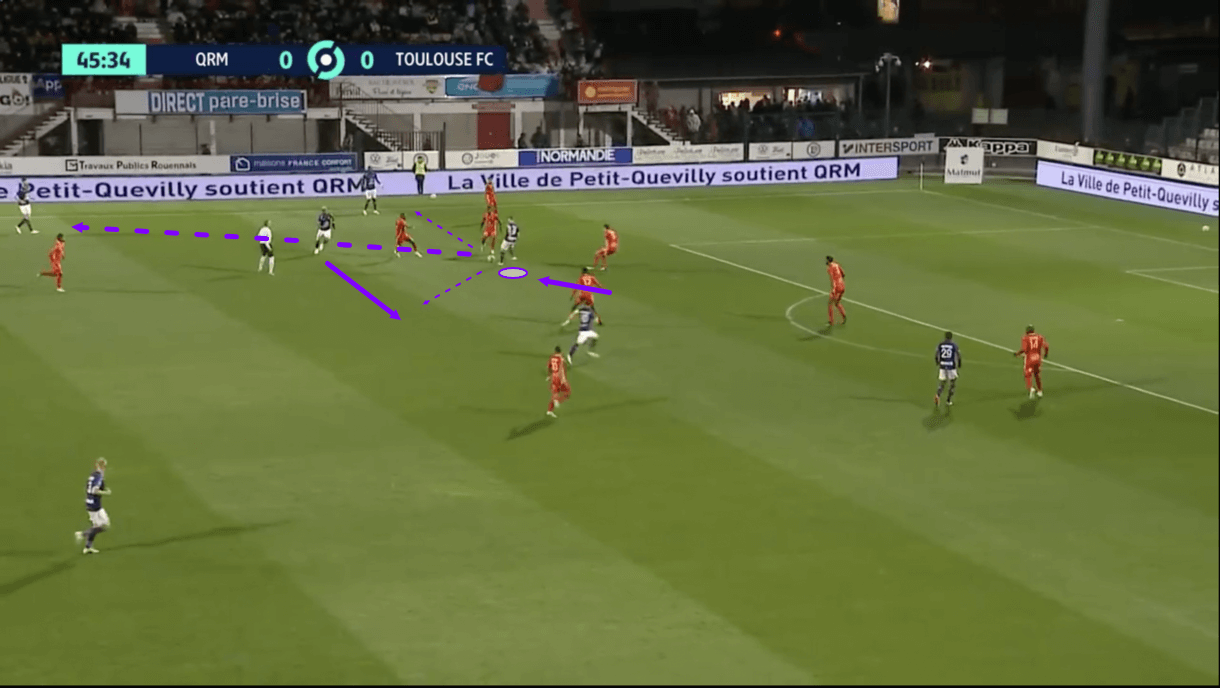
We return to this passage of play in figure 6, which shows the state of play just after Healey had received the forward pass from his teammate. At this point, we see the forward picking up the ball with a few different options to choose from. He had one teammate pinned wide on the left-wing, one teammate sitting even deeper on the left-wing, and the previous ball-carrier who’d just sent the ball into his feet can now be seen running into a more central position, giving Healey a slightly different passing option.
Had Healey taken an extra second or two to get his head up, survey the pitch and assess his options, he may have chosen one of the two closer options — the teammate on the wing or, even better, the teammate running into space centrally. However, on receiving the ball, Healey kept his head down and sent it back to the deepest of these three options — finding a player in plenty of space, but in a far less threatening position.
A player more adept to engaging in intricate link-up play may have chosen a different option here, with controlling the ball and turning to carry it into space another viable possibility. However, Healey’s just not that player. He has limitations and link-up play is one area in which those limitations exist. In general, he and his team are aware of those limitations and do a good job of masking them, explaining, for instance, why he doesn’t drop off and engage in link-up play very often. However, as this example shows, even for Healey, it’s sometimes inevitable that the centre-forward needs to play with his back to goal and link up with teammates. While Healey’s movement and positioning before receiving the ball was effective, his showing on the ball did highlight his limitations, to an extent, but still, he did well to give his teammate an option, relieve some pressure, and at least find another teammate with his subsequent pass.
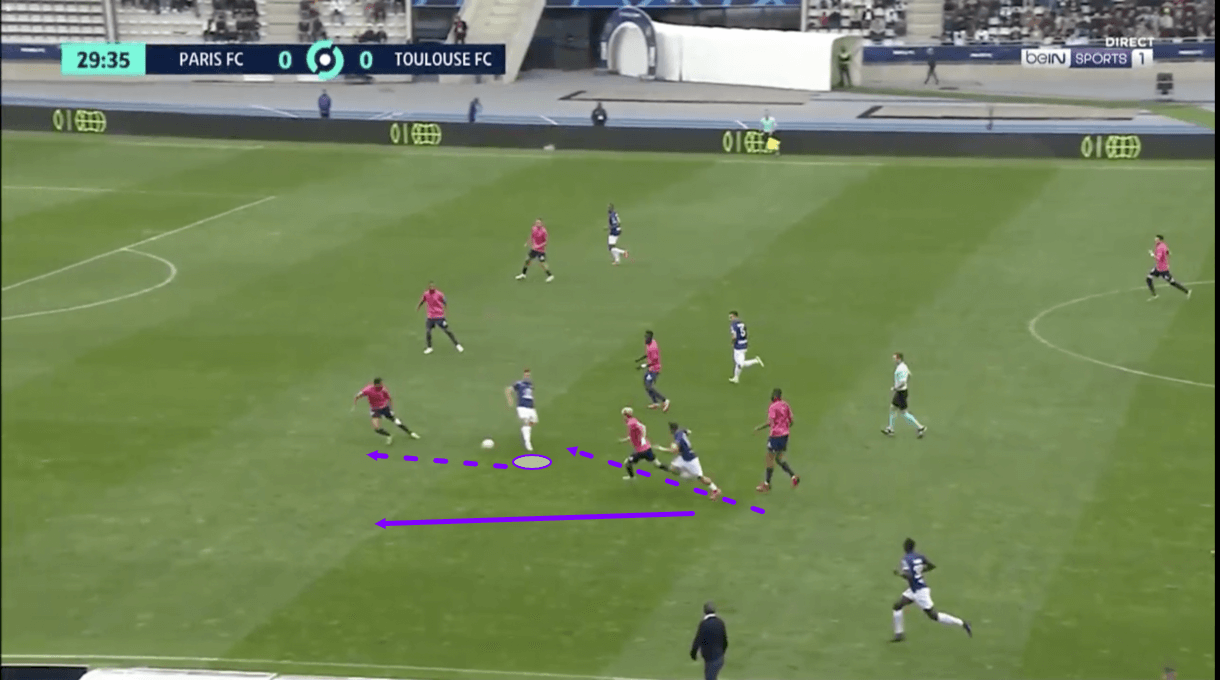
Figure 7 highlights an example of another time this season when Healey dropped from his high starting position on the shoulders of the opposition defence to a deeper position where he could give teammates an option for link-up play. Just before this image, we saw the Englishman drop deep into the inside right channel to give a ball-carrier moving from deep a forward passing option under pressure. Again, Healey’s movement and positioning were effective. He successfully provided the ball carrier with a good forward passing option.
However, as we know at this point, movement and positioning are not the issue for Healey. While the Englishman was able to offer a passing option, his next move, on receiving the ball, is where he let himself down. The Toulouse player who’d just found Healey with a pass continued his run as the Englishman dropped to meet the ball, and the 26-year-old forward looked to return the ball to the runner via a flicked pass with the outside of his stronger right foot.
Healey’s idea here was good, which is often the case for him. Unfortunately, for him and Toulouse, Healey’s execution was not so impressive and as play moves on from here, we see the Englishman’s attempted flicked pass screw too far away from the intended receiver and into the feet of the opposition defender positioned just behind Healey in figure 7.
So, this passage of play highlights that while Healey’s movement and positioning are often positive, and he can indicate positive ideas, his technique does fail to allow him to pull off what his mind tells him to try, which ultimately leads to attacks breaking down for Toulouse, as was the case here in figure 7.
Ball control, dribbling and agility
In this next section of analysis, I’m going to spend some time focusing on what could be a very underrated aspect of Healey’s game — his ball control and dribbling ability. While Healey’s technique, in terms of passing, lets him down at times, he’s frequently demonstrated good technique on the ball when holding onto possession himself and evading challenges at times this season.
Again, this is an area of limitation for the 26-year-old. Don’t expect to see Healey picking up the ball and setting off on a mazy run through multiple opposition players. Importantly, though, on a positive note, the Englishman is aware of his limitations and as a result, doesn’t try to do things that he knows are not in his wheelhouse. Healey’s capable of demonstrating good ball control, dribbling technique, and impressive agility within the confines of his comfort zone, on the pitch, however.
This season, the Toulouse man has engaged in 2.68 dribbles per 90 — which is not a lot of dribbles relative to other Ligue 2 strikers. This isn’t a surprise, knowing Healey’s game, as he very rarely drops to receive the ball to feet and doesn’t try to carry the ball around the pitch or set off on mazy runs to slalom through opposition defenders. Positively, though, while he’s made few dribbles relative to other strikers, Healey’s dribble success rate is decent, at 52.78%. This is indicative of the fact that Healey knows his limitations when it comes to dribbling and doesn’t try to do too much outside of his capabilities, but when sticking to what he’s comfortable with, can be an asset for his side, which we’ll explore via a couple of examples in this section of analysis.
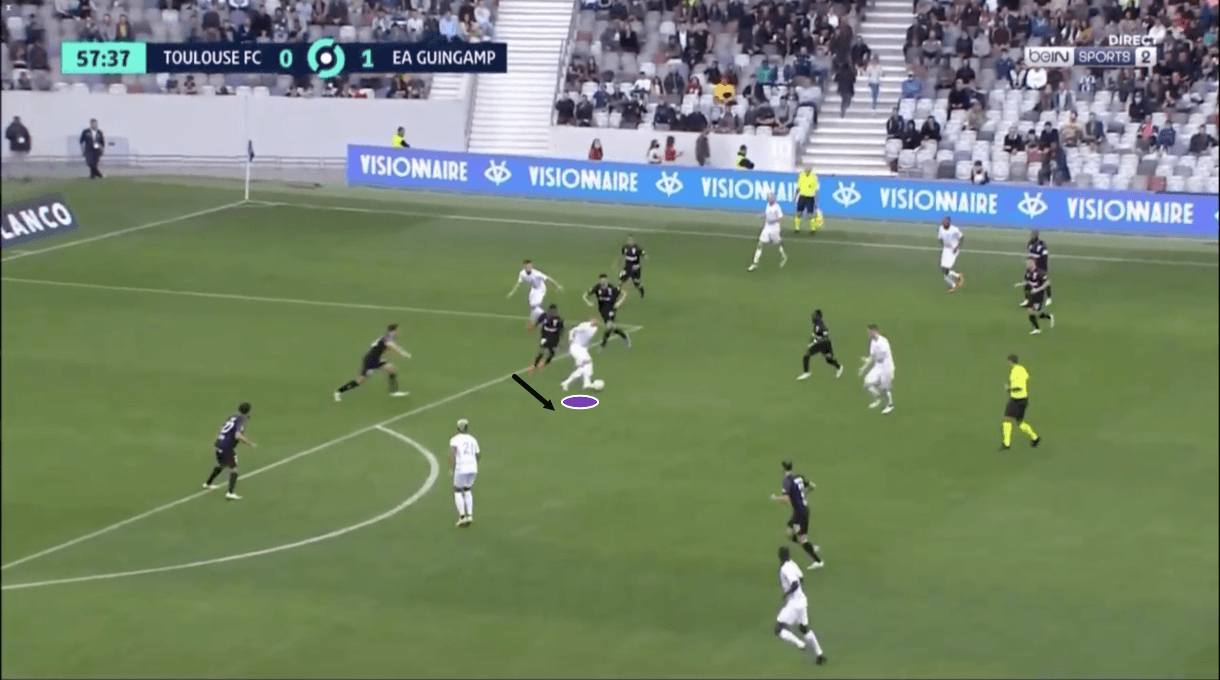
Starting with figure 8, here we see an example of Healey picking up the ball with his back to goal on the edge of the box, with an opposition defender closing him down from behind but without a defender specifically marking him at this moment. Just before this image, the striker again demonstrated some good movement to position himself in space on the edge of the area to receive a pass from a deeper teammate, again to relieve some pressure on the previous ball-carrier. On receiving the ball here, Healey immediately attracts attention from several opposition players whose focus is now on congesting the space around the attacker.
Healey isn’t one to turn towards goal and look to carry the ball past the centre-backs into the penalty area in a situation like this, as it would be beyond his capabilities. However, as we can see from figure 8, he has some space to his left which can be targeted to overload that wing and keep the Toulouse attack moving.
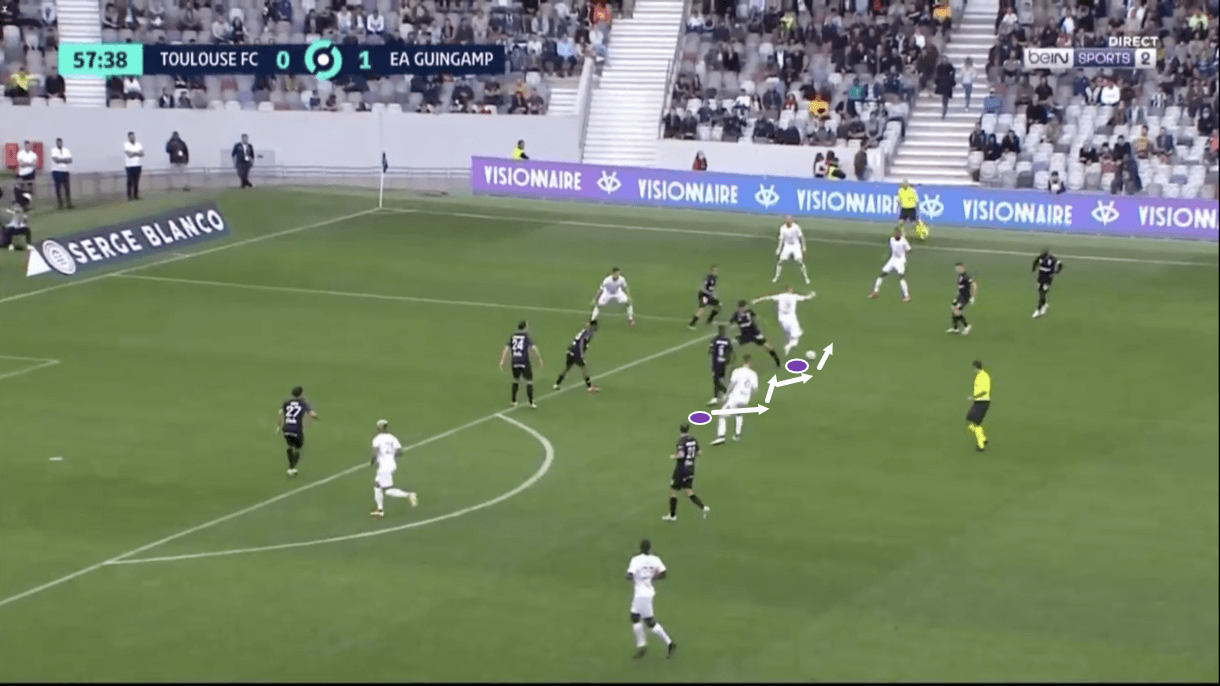
Healey doesn’t hesitate to exploit that space and as play moves on into figure 9, we see that the forward has exited to his left to occupy the right half-space for Toulouse. As play moves on from here, we see him pass the ball to one of the two wide men on the right to successfully keep this attack moving. While Healey didn’t break lines with his pass or create a great chance by putting the ball into a very high-value area here, he did successfully retain possession for his side and give Toulouse a chance to keep the attack moving.
The 26-year-old did well to dodge challenges while making his way into the right half-space, with Healey skipping past two opposition players while making this run towards the wide area. Each time, he had some space on the opposite side of the defender to shift himself and the ball into while using his impressive agility to turn quickly and evade the defenders’ attempted tackles. At no point was Healey trapped in a tight area. He drew individual opposition defenders in one-by-one and used the space on the opposite side to help skip past those players while carrying the ball onto the right-wing.
This shows an excellent example of what Healey can bring to the table for his side while dribbling. He’s got quick feet and he’s good at evading challenges while carrying the ball in a particular direction. A well-coordinated press that does a better job of closing the space around Healey would likely succeed in dispossessing him, as he is limited on the ball. However, in 1v1 duels, the attacker is more than capable, at Ligue 2 level, of beating his man and carrying the ball onwards.
This is part of what makes me believe Healey could be a very good wide forward on the left, where he could look to cut inside onto his stronger right foot. His ability in 1v1 duels is impressive, he’s got a good ability to turn quickly thanks to his agility, he’s very quick, and he’s an efficient finisher with a powerful shot who would be able to punish defenders quickly after knocking the ball past them. We’ve seen Healey pull onto the left-wing at times this season before cutting in onto his stronger right foot to good effect and I feel this is a skill he could use even more frequently, whether that’s while being deployed as a left inside forward or as a left centre-forward in a two-man strike partnership.
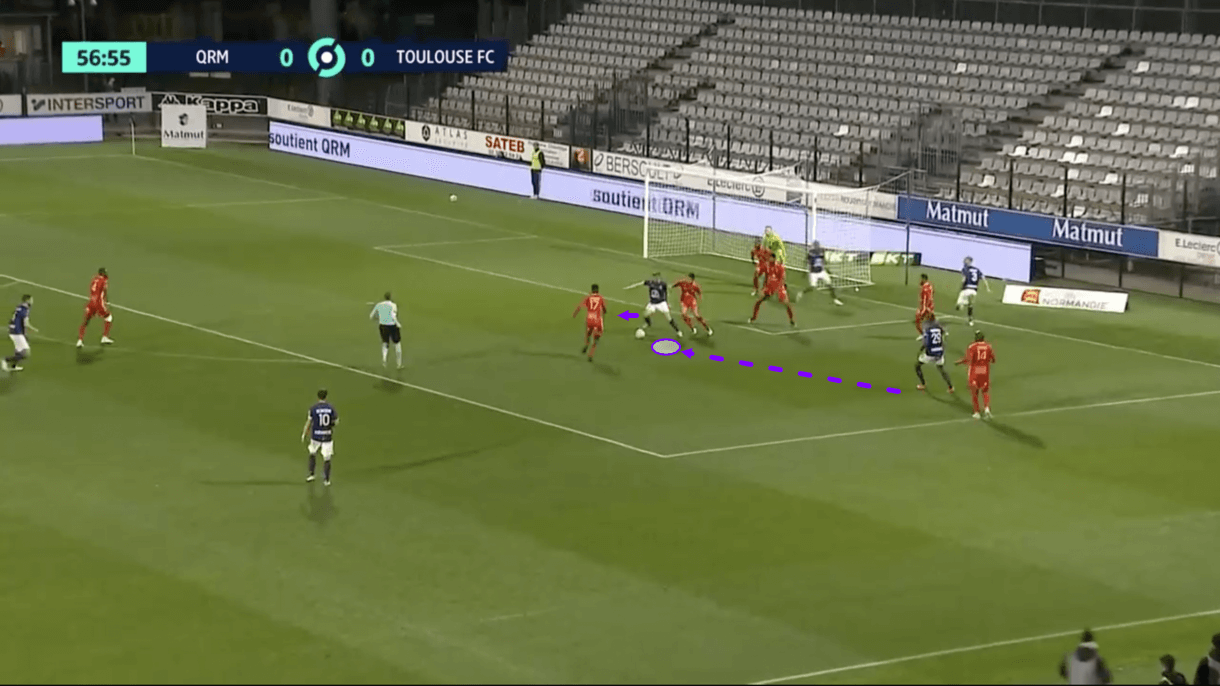
Healey’s quick feet and agility are also on display in figures 10-11. Here, we’ll analyse a passage of play that highlights something of a trademark move in the attacker’s arsenal when on the ball with his back to goal inside the box. Firstly, starting with figure 10, we see Healey positioned centrally inside the box with his back to goal, having just received the ball to feet via a low cross from his teammate who’s now positioned just inside the box here.
As mentioned earlier while discussing Healey’s movement and positioning, the 26-year-old needs to get himself into space in high-value positions during the chance creation phase, so he’s in a good position to receive the ball from a teammate via a cross or through pass before, ideally, finishing efficiently. However, sometimes opposition defenders will do a good job of protecting the central space and preventing Healey from getting a quick shot off from these high-value positions he occupies, with figure 10 providing a good example of one occasion when this was the case.
Here, Healey’s had to receive with his back to goal, aiming to protect the ball from the defender between him and the goal, while buying himself some seconds to plan his next move. The 180cm forward isn’t very short but he’s definitely not physically imposing, by any means. You won’t catch Healey backing into players and trying to bully them physically.
Occasionally, he does have to back into players — if Toulouse send a long ball his way, for example, which is rare due to his physical limitations — and on those occasions, he generally doesn’t come out successfully. Either the opposition defender will outmuscle him and win the duel, which is often the case, or Healey will put so much effort into the physical duel that his technique lets him down and he ends up losing possession through a heavy touch.
In general, though, Healey will try to avoid physical battles, as was the case here, where he’s retained some distance between himself and the defender. To try and beat the opposition defender behind him, Healey pulls off a move that’s a very common part of his game. Firstly, as seen in figure 10, he pushes the ball to one direction, shaping his body as if he’s preparing to turn in that direction also. On this occasion, we see him knocking the ball towards the centre of the box with the outside of his right foot before looking to turn in that direction.
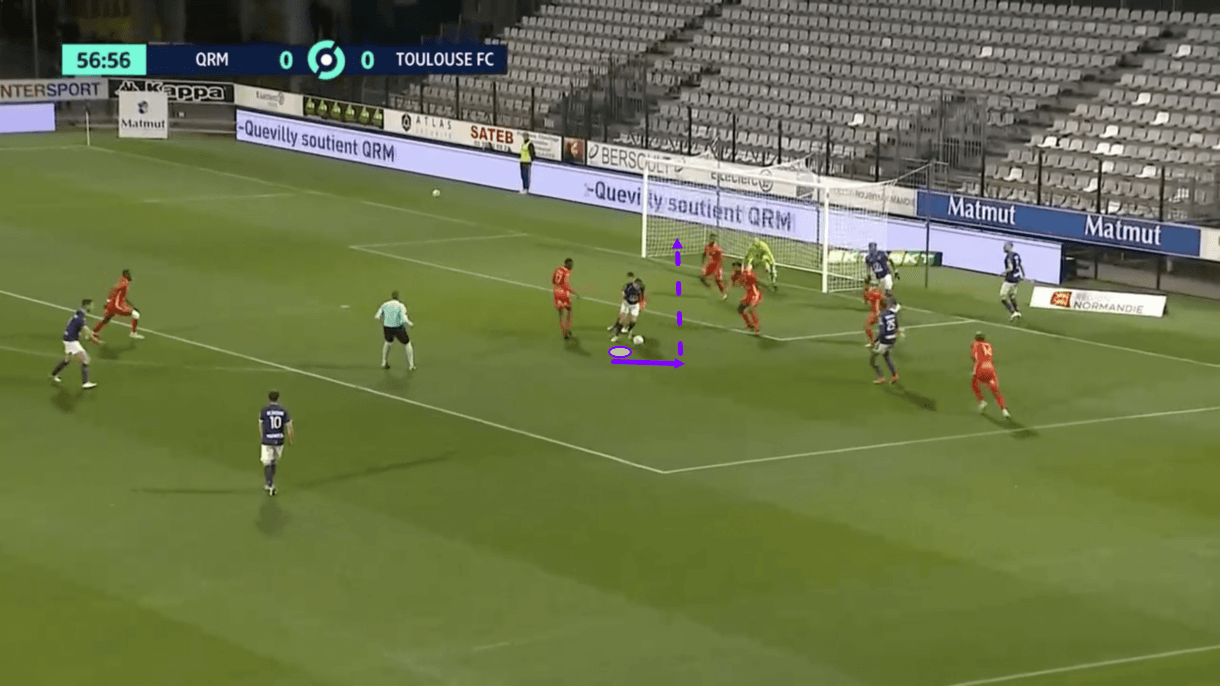
As play moves on into figure 11, however, we see that Healey has got the ball on the other side of his body. This demonstrates his agility, via his impressive ability to turn quickly, as well as some good technique. After shifting the ball onto his left in figure 10, Healey quickly got his right foot around the ball and knocked it back towards the right side of the box and to his right side too.
Healey’s initial touch and movement onto his left dragged the defender behind him to that side as well, and as figure 11 shows, when the Englishman knocks the ball back onto his right side, he’s got a clearer line of sight to goal on his stronger foot. It’s worth noting, however, that while Healey is right-footed, his weak foot is relatively strong and he’s comfortable with pulling off this manoeuvre in the opposite directions too (first going to his right, before pulling the ball back onto his left). The move is less about getting the ball onto one particular foot than it is about creating a clear shooting angle. After creating the shooting angle, Healey then looks to spin quickly to take a snapshot at goal.
On this occasion, Healey dragged his shot wide. However, the Englishman pulled off a very similar move to score a wonder goal on his left foot in his side’s recent 2-2 draw with Paris FC, highlighting both the effectiveness of this dribbling manoeuvre as well as Healey’s solid weaker foot.
Conclusion
To conclude this tactical analysis and scout report, Healey is a limited player. He’s not a great asset for link-up play and he’s not got incredible technique, though he demonstrates some decent dribbling quality in certain situations, as we’ve analysed, while he’s also certainly not a great physical specimen either who’s going to dominate defenders through his strength. Healey is a great asset if his limitations are made less important through his specific role within his team’s strategy and tactics, however, which is the case at Toulouse.
Healey is an efficient finisher with rapid pace who demonstrates great off-the-ball movement to position himself optimally in the chance creation phase for finishing opportunities. He’s good at hanging out on the shoulders of the opposition’s backline before exploding into action to get onto the end of a ball in behind and exploit space, while he’s good at finding an inch of space inside the box in high-value positions, to make himself an attractive passing/crossing option for teammates just before shooting when the attack is slightly more advanced.
Toulouse’s effective use of Healey, as well as the attacker’s strong understanding with his teammates in terms of role, preferences and ability, is why the Connah’s Quay academy product is thriving in France’s second-tier.





Comments